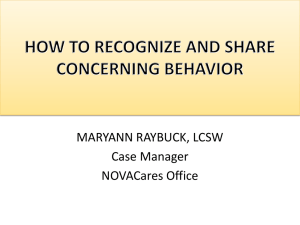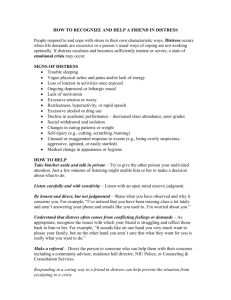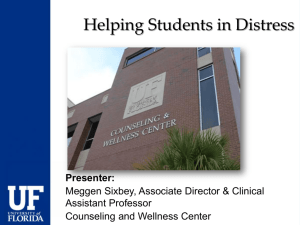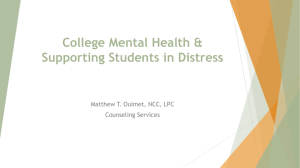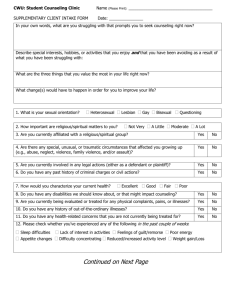Communicating with a Student in Distress
advertisement
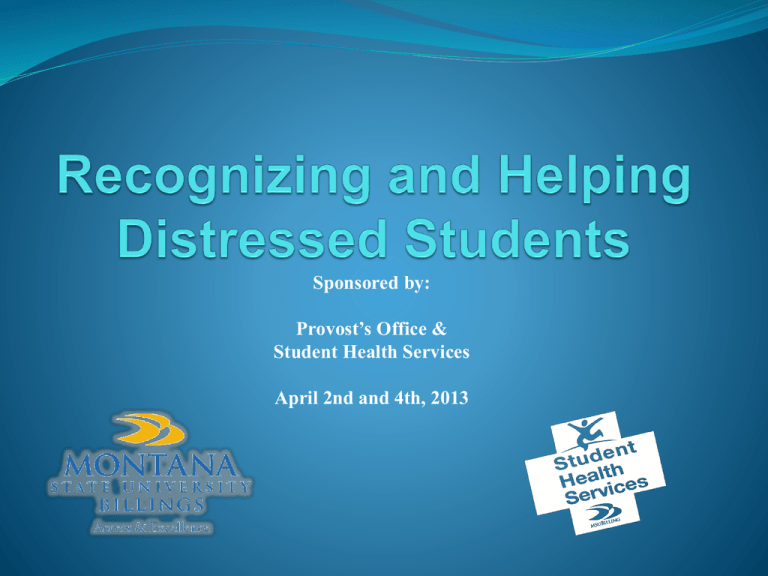
Sponsored by: Provost’s Office & Student Health Services April 2nd and 4th, 2013 Overview: Statistics re: college students and mental health Recognizing warning signs of distress Communicating with a student in distress Referring students for help Managing student requests and situations Top 5 Academic Impacts MSUB ACHA-NCHA II Fall 2012 (N=588) 1. 2. 3. 4. 5. Stress 26.6% Sleep 21.5% Work 21.1% Anxiety 20.4% Depression 13.4% National Data Spring 2012 (N= 90,666) 1. 2. 3. 4. 5. Stress 29.0% Sleep 20.6% Anxiety 20.2% Cold/Flu/Sore Throat 15.6% Work 13.9% “Academic Impact” Received a lower grade on an exam, or an important project; Received a lower grade in the course; Received an incomplete or dropped the course; Or experienced a significant disruption in thesis, dissertation, research, or practicum work Stress and Sleep 48% rated their overall level of stress as “more than average” 63% felt “tired, dragged out, or sleepy” at least 3 days/week 54% felt they did not get enough sleep to feel rested in the morning at least 3 of the past 7 days Mental Health Within the last 12 months, % of students who said the following has been traumatic or very difficult to handle: National Data: Finances Academics Family problems Sleep difficulties Intimate relationships Career-related issue 47% 40% 33% 31% 29% 29% Academics Finances Intimate Relationships Family problems Sleep difficulties Other social relationships 46% 34% 32% 28% 26% 25% Mental Health Within the last 12 months: 85% felt overwhelmed by all they had to do 31% felt so depressed it was hard to function 49% felt overwhelming anxiety 36% felt overwhelming anger 7% seriously considered suicide * Note: What may be the unintended message we send students when we craft and ask these questions (vs. questions that focus on resiliency)? National Data: 86% felt overwhelmed by all they had to do 31% felt so depressed it was hard to function 51% felt overwhelming anxiety 37% felt overwhelming anger 7% seriously considered suicide NAMI Survey data 64% of students who experience mental health problems end up withdrawing 50% of students who withdrew from school never accessed college mental health services and support 78% believe mental health training very important for faculty/staff 22% learned about college services through faculty or staff National Alliance on Mental Illness web-based survey August-November 2011 N=765 Recognizing Students in Distress Students in mild distress may exhibit behaviors that do not disrupt others but may indicate something is wrong and that assistance is needed. Behaviors may include: Serious grade problems or a change from consistently passing grades to unaccountably poor performance. Excessive absences, especially if the student has previously demonstrated consistent attendance. Unusual or markedly changed patterns of interaction Other characteristics that suggest the student is having trouble managing stress successfully Adapted from University of Michigan (2008) Recognizing Students in Distress Students in moderate distress may exhibit behaviors that indicate significant emotional distress. They may also be reluctant or unable to acknowledge a need for personal help. Behaviors include: Repeated requests for special consideration, especially if the student appears uncomfortable or highly emotional. New or repeated behavior which interferes with effective management of the immediate environment. Unusual or exaggerated emotional responses that are obviously inappropriate to the situation. Adapted from University of Michigan (2008) Recognizing Students in Distress Students in severe distress exhibit behaviors that signify a crisis and that necessitate emergency care. Behaviors include: Highly disruptive behavior Inability to communicate clearly Loss of contact with reality Stalking behaviors. Inappropriate communications Overtly suicidal thoughts or threats to harm others Adapted from University of Michigan (2008) Recognizing Students In Distress Symptoms of Depression Persistent sadness Feelings of hopelessness, worthlessness, guilt Lack of motivation Lack of enjoyment of activities or class material the person previously enjoyed Sleep disturbance Significant weight gain or loss Suicidal ideation Recognizing Students in Distress Symptoms of Anxiety Excessive worry that is difficult to control Restlessness Fatigue Difficulty concentrating Irritability Muscle tension Sleep disturbance Panic attacks Recognizing Students in Distress Symptoms of Psychosis Delusions (false beliefs) Hallucinations (false sensory experiences) Disorganized speech Disorganized behavior Flat or inappropriate affect (emotional display) Absence of motivation Speech disturbances Change in hygiene and appearance Recognizing Students in Distress Counseling isn’t just for mental illness! Time management techniques Stress management techniques Sleep hygiene Balancing work/family/school Help managing significant life events (e.g., break-ups, homesickness, roommate difficulties) Communication and interpersonal skills Relationship issues Communicating with a Student in Distress Move the student to a quiet and secure location Express your concerns in behavioral, nonjudgmental terms Be direct and specific Avoid judging, evaluating or criticizing – respect the student’s value system even if you disagree Listen attentively Give student your undivided attention Communicate understanding by repeating what he/she has told you Let the student talk Do not minimize or immediately provide reassurance Praise student for openness and honesty Remain calm and respond in a soothing manner Validate the student’s feelings and experiences Take the student seriously Be supportive and express your concern about the situation A Victimized Student Recognize the student may be vulnerable and experiencing a range of intense feelings, including shame, anger, fear and denial Believe the student Respect the student’s right to make his/her own decision Let the student know that you must, as a university employee, report any abuse, but it can be reported as a “Jane or John Doe” Refer to MSUB Student in Distress Guide www.msubillings.edu/VCSA/PDF/GuideforFacStaffStudentBehavior.pdf • • • • • A Severely Disoriented or Psychotic Student Recognize that psychotic states can involve extreme emotion or lack of emotion and intense fear to the point of paranoia Recognize that a student in this state may be dangerous to self or others Call Campus Police (2222) before you see the student so they can be in the area in case you need them Alert someone else near you that you are seeing a student and may need assistance Speak to the student in a direct and concrete manner regarding your plan for getting him/her to a safe environment The Aggressive, Angry or Potentially Violent Student • • • Assess your level of safety – Call 911 or Campus Police at 2222 if you feel in danger (9911 if on campus) Remain in an open area with a visible means of escape Explain to the student the behaviors that are unacceptable • Stay calm and gain control of the situation by setting limits • Use a time-out strategy (that is, ask the student to reschedule a meeting with you once he/she has calmed down) if the student refuses to cooperate and remains aggressive or agitated The Depressed or Suicidal Student • • • • Let the student know you are aware he/she is feeling down and you would like to provide support and assistance Ask the student if he/she has thoughts of suicide Take the student’s disclosure as a serious plea for help Express care and concern and assure the student that you will help him/her reach a professional Distance Education • • If any of the situations discussed here are expressed by your online students, the same communication skills apply. The referral information, however, changes. Mental Health counseling is not available over the phone to students. • • You could ask the student if they have ever seen a counselor and suggest he/she call that person You could look online for resources in the student’s geographical area and refer them Recommendations Do not become involved with a student beyond your level of expertise or comfort Do not ignore comments such as, “I won’t be a problem much longer” Do not become anxious or overwhelmed yourself Do not minimize the seriousness of the student’s behavior Do not become defensive or get into an argument or shouting match Do not convey judgment or criticism Do not act hostile or punitive Do not make assumptions Referring a Student For Professional Help WHEN TO REFER • • • • • Student remains distressed following repeated attempts by you and others to be helpful Student becomes increasingly isolated, unkempt, irritable or disconnected Student’s academic or social performance deteriorates Student behavior reflects increased hopelessness or helplessness You are doing on-going counseling rather than advising How to Refer Speak to student in direct concerned straightforward manner Be caring but firm in recommending counseling. Be clear about reasons concerned Be knowledgeable in advance about services and procedures of SHS Counseling or other campus agencies Suggest student make an appointment and provide phone number for referral Remind student that counseling is free and confidential You may need to be more active in assisting student in making appointment, or walk them to Student Health Services Student Health Services The Student Health Services provides high-quality, cost-effective health care and mental health counseling with an emphasis on health education and wellness initiatives to promote and enhance student success. Hours : University Campus Clinic & Counseling Monday-Friday 8:00a - 5:00p 2nd Floor Petro Hall City College Clinic: Mon, 1p-4:30p; Wed, 9a - 12p; Tue & Thu, 11p - 2p Tech Bldg. 2nd Floor Counseling: Mon, 9a-4p; Wed 9a-12 noon; Thu, 8a - 11a Phone: University Campus: (406) 657-2153 City College Phone: (406) 247-3027 www.msubillings.edu/studenthealth Campus Police For emergencies dial extension 2222 For Billings Police emergencies and medical emergencies dial 911 (9911 if on campus) Sign up for MSUB alerts http://www.msubillings.edu/msubalert/ www.msubillings.edu/police/ TRIO and SOS Provides academic support and individualized assistance to first generation, low income or students with disabilities Services include: Peer mentoring, study groups/tutors, access to cultural events, workshops, financial information, counseling and referral, midterm evaluations, newsletters, assistance in graduation preparation, return to learn and SOS activity club Student Opportunity Services/TRIO Library, LI 141 Phone: (406) 657-2162 Fax: (406) 657-1667 Office Hours: 8:00 am to 5:00 pm M-F www.msubillings.edu/sos/ ASC – Academic Support Center Offers classes in reading, developmental math and developmental reading Tutoring for math, writing, reading, science, psychology and foreign languages Services are FREE (prepaid in tuition) University ASC front desk 657-1641 City College ASC front desk 247-3022 www.msubillings.edu/asc/ DSS – Disability Support Services Works with issues related to physical access and issues related to course content Accessible technology 4 testing rooms DSS does not offer tutoring, mental health counseling, financial assistance, personal care attendants or mobility equipment DSS cannot by law contact a student but you can refer College of Education Room 135 657-2161 City College Room A008 247-3029 www.msubillings.edu/dss/ Managing Student Requests & Situations—Some Key Components Location Safety Thorough Assessment Problem Solving Referral Clear Communication Avoid Judgment Boundaries & Competence Active Listening & Validation Supports/Consultation TAKE CARE OF YOURSELF! Unconfirmed Diagnosis “I think I’m bipolar.” “I’m pretty sure I have ADHD.” “I have test anxiety.” Think about student welfare Take them seriously – refer them for diagnosis & treatment Win-win Let them know about DSS & other supportive programs Refusal to Work with Medical/ Mental Health “They don’t understand me.” “They say I’m faking it.” Any accommodation should go through some path (e.g., SHS, DSS, etc.) Acknowledge & validate fears/concerns Encourage referral Excessive Requests “Can I do a special study session with you instead of the TA?” “Will you change my grade for the last exam? My bipolar was really acting up that day.” “My social anxiety is really bad. Can I skip the required presentation for this class?” Excessive Requests (Continued) Here are some UNreasonable accommodations: Anything that poses a threat to health/safety of others Substantial change in essential element of curriculum (e.g., dropping presentation requirement for speech course) Altering course objectives (e.g., waiving the writing element of a course) Undue financial/administrative burden to institution For Additional Assistance Student Health Services Mental Health Counselors 657-2153 Linda Crummett Judy Silverman Amber McDermott (also in Dept of Rehab & Human Services) Kim Waldmann Department of Psychology 657-2242 or 657-2250 (direct #) Marie Schaaf Gallagher Resources Helping Students in Distress--A Faculty and Staff Guide for Assisting Students in Need University of Maryland Counseling Center http://www.cte.umd.edu/HSID.pdf Reaching Out Resources for Responding to Students in Distress Boise State University Health and Recreation Counseling Services http://healthservices.boisestate.edu/resources/materials/reachingOutHandbook.pdf Student in Distress and Sexual Harassment: A Guide for Faculty and Staff MSU Billings http://www.msubillings.edu/VCSA/PDF/GuideforFacStaff-StudentBehavior.pdf National Alliance on Mental Illness web-based survey August-November 2011 N=765 http://www.nami.org/Content/NavigationMenu/Find_Support/NAMI_on_Campus1/NAM I_Survey_on_College_Students/collegereport.pdf Discussion: Other Student Requests/Situations?
